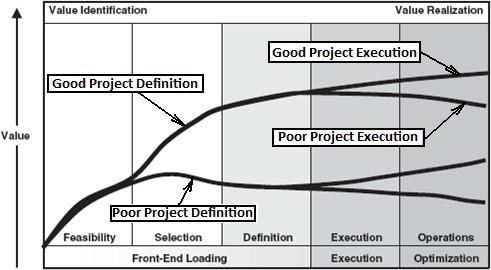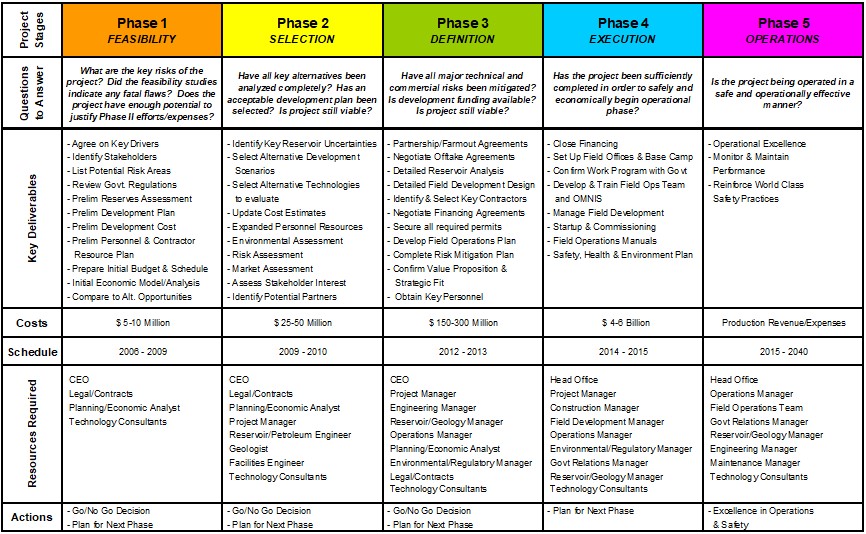19 Sep How the Stage Gate Project Management Process will improve your project results
In order to effectively manage a project, a structured approach toward project management is needed. A Stage Gate Project Management Process is recommended for this purpose. It is a process that has been accepted in many industries as a way to optimize shareholder value by improving the quality of early-phase decisions and increasing the likelihood for successful projects. Under a Stage-Gate Project Management Process, the appraisal, development and final operation of a major capital project is broken into “phases”. Each phase has very specific work programs and objective ends with a specific point where a decision is made to move the project to the next phase, re-do the phase, or stop the project altogether.
The first three phases are focused on value identification and are frequently referred to collectively as “Front End Loading” (FEL).

Phase 1 (FEL1) – Feasibility: The feasibility phase should answer very basic questions such as: a) is the project feasible?, b) what are the key elements that drive value in the project?, c) what are the givens and boundary conditions for the project?, d) which are the key stakeholders for the project?, and e) what are the full-life cycle risk factors? During this phase, the project team and management also should determine if the project is aligned with the Country’s strategic vision and policy for the energy sector.
Phase 2 (FEL2) – Selection: The goal of the Selection Phase or Phase 2 is to select the best development plan out of a wide range of development and commercialization concepts. The determination of “best” requires the evaluation and trade-off of multiple value drivers based on technical, economic, commercial and policy factors. This phase requires a balanced mixture of creativity and discipline that allows the project team to identify and evaluate alternatives that will lead to the maximum creation of value to the country. At the end of this phase, a preferred development plan is identified that will be the basis of the next phase activities.
Phase 3 (FEL3) – Definition: During Phase 3 or Definition Phase, the selected development alternative is further studied and defined in sufficient detail to support a Final Investment Decision (FID). Typically, this requires a Front-End Engineering Design package to be developed, based on the work completed during the earlier phases.
The critical importance of appropriate decision making during the Front-End Loading phases, especially the Feasibility and Selection Phases, is shown below. This diagram schematically portrays the value creation journey of a typical project. Most of a project’s value is created during the first two phases, through a disciplined and creative definition of the project and the assessment of project alternatives. The difference in value from the two curves shown below (splitting at the end of the Feasibility Phase) corresponds to the value creation generated through appropriate alternative selection versus the destruction of value seen in the selection of an incorrect or inefficient project plan. Once a development option is selected and defined during Phases 2 and 3, the incremental value created (or destroyed) through execution and operation (the two sub-branches during Phases 4 and 5) is relatively small.

Project Framing
The use of a Stage-Gate PMP begins with Project Framing which involves establishing the scope for the opportunity assessment. Project framing is the front-end of a robust decision-making process. It is the most critical step to ensuring quality and clarity of decisions. Sometimes a project team drives for results so quickly that they miss developing the clarity of purpose, alignment of the project team/stakeholders, the identification of value enhancers and the early identification of critical issues.
The appropriate framing of a project or opportunity is very important. A frame that is too broad could easily result in a project team being overwhelmed and paralyzed with no effective decisions being generated. If the frame is too narrow, a project team could miss important aspects or risks of a project, due to these not being considered and evaluated.
By developing a correct frame, the project team and stakeholders build alignment on the principal goals and drivers of the project. First you have to define the project’s current state (where are you now?), then define the desired state (where do you want to be?), and finally

prepare a plan to reach the desired state (how do you get there?)
(see Figure 3 below).
The development of a project frame should include the following steps:
- Develop an Opportunity Statement
- Define the Boundary Conditions
- Identify the Stakeholders
- Generate a Definition of Success
- Develop a Project Roadmap
Opportunity Statement: The first step in developing an opportunity statement for a project is to assess the project’s alignment with the vision and strategic goals of the Company.
Boundary Conditions: The next step in developing a project frame is to define boundary conditions for the project. Boundary conditions apply to the current phase of the project and should be revisited at the beginning of each subsequent phase. Boundary conditions limit or define the scope of the work the project team will do during this particular development phase.
- In the Frame: These are the “givens” and items which are within the project’s scope
- On the Frame: These are items which may need further clarification in a later phase
- Off the Frame: These are items which are currently excluded from the project’s scope
Identify Stakeholders: One of the most important steps in the successful development of a project is to identify the stakeholders and their role/impact in project decisions.
Generate a Definition of Success: The next ingredient to a successful project framing exercise is to generate a definition of success. The definition of success should include a vision of what success should look like, including success factors and metrics to help identify when success is achieved. This simple exercise brings alignment between the project team and stakeholders and assists the project team to focus only on the work which contributes to the agreed-upon definition of success.
Develop a Project Roadmap: The previous steps in project framing described above are prerequisites to the development of a project roadmap. A project roadmap provides a guide for the management and project team to navigate through all of the details and priorities of a very complex project.
A project roadmap should include the following sections:
- Questions to Answer: These are key questions that need to be answered during each development phase of a project.
- Key Deliverables: These are the significant activities and deliverables needed to be completed during each phase in order to answer the key questions outlined above. The key deliverables are collected into a comprehensive Decision Support Package (“DSP”) at the end of each phase.
- Costs: What are the estimated costs for completing the work items identified in the Key Deliverables section for each phase?
- Schedule: What is the estimated time required to complete the work items for each phase?
- Resources Required: This section identifies the core project team and third party resources required for carrying out the work items identified above.
- Actions: This identifies the key decisions that are needed from the Decision Review Board at the end of each phase.
A benefit of developing a project roadmap is the ability to communicate more effectively with decision makers. The decision makers can see where the project team is taking the project, what their interactions will be and when they will need to make decisions. The roadmap provides an opportunity for those involved to see the entire plan from start to finish and resolve questions in a timely and effective manner.


